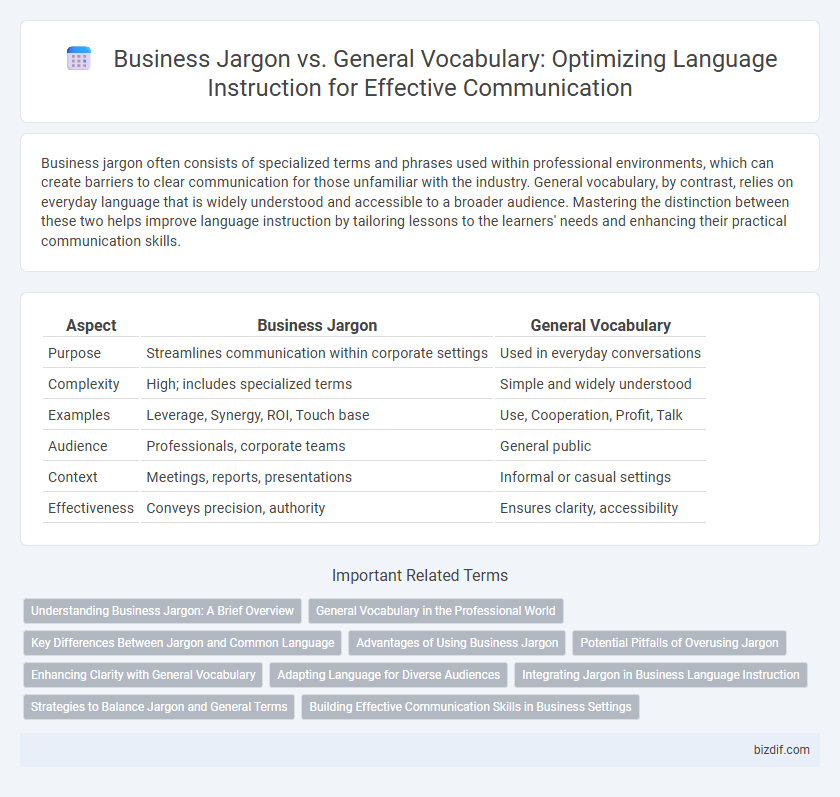Business jargon often consists of specialized terms and phrases used within professional environments, which can create barriers to clear communication for those unfamiliar with the industry. General vocabulary, by contrast, relies on everyday language that is widely understood and accessible to a broader audience. Mastering the distinction between these two helps improve language instruction by tailoring lessons to the learners' needs and enhancing their practical communication skills.
Table of Comparison
| Aspect | Business Jargon | General Vocabulary |
|---|---|---|
| Purpose | Streamlines communication within corporate settings | Used in everyday conversations |
| Complexity | High; includes specialized terms | Simple and widely understood |
| Examples | Leverage, Synergy, ROI, Touch base | Use, Cooperation, Profit, Talk |
| Audience | Professionals, corporate teams | General public |
| Context | Meetings, reports, presentations | Informal or casual settings |
| Effectiveness | Conveys precision, authority | Ensures clarity, accessibility |
Understanding Business Jargon: A Brief Overview
Business jargon consists of specialized terms and phrases used within corporate environments to convey complex ideas efficiently. Understanding business jargon enhances communication by enabling professionals to interpret and use industry-specific language correctly, thereby improving collaboration and decision-making. Mastery of common expressions such as "ROI," "leverage," and "synergy" is essential for navigating meetings, reports, and negotiations effectively.
General Vocabulary in the Professional World
General vocabulary in the professional world enhances clear communication by avoiding the complexity and ambiguity often found in business jargon. Using widely understood terms facilitates collaboration across diverse teams and ensures messages are accessible to clients, stakeholders, and colleagues from various industries. Mastery of general vocabulary supports effective written and verbal communication critical for successful business operations and relationship management.
Key Differences Between Jargon and Common Language
Business jargon consists of specialized terms and phrases used within professional industries to convey precise meanings quickly, often unfamiliar to the general public. General vocabulary includes everyday words understood broadly across various contexts without requiring specific industry knowledge. The key differences lie in jargon's specificity, exclusivity, and efficiency for experts compared to the accessibility and simplicity of common language.
Advantages of Using Business Jargon
Using business jargon enhances communication efficiency by conveying complex concepts quickly and precisely among professionals. It establishes credibility and fosters a sense of belonging within corporate culture, facilitating smoother collaboration. Mastery of industry-specific terminology also aids in networking and career advancement by demonstrating expertise.
Potential Pitfalls of Overusing Jargon
Excessive use of business jargon can alienate employees and clients who are unfamiliar with specialized terms, leading to miscommunication and reduced engagement. Overreliance on jargon often obscures clear messaging and complicates understanding, hindering effective decision-making and collaboration. Prioritizing plain language in business communication fosters inclusivity and ensures that essential information is accessible to a broader audience.
Enhancing Clarity with General Vocabulary
Using general vocabulary in business communication enhances clarity by minimizing misunderstandings often caused by specialized jargon. Clear and simple language ensures messages are accessible to a broader audience, including non-native speakers and cross-functional teams. Prioritizing straightforward terms improves engagement and facilitates effective decision-making across diverse business environments.
Adapting Language for Diverse Audiences
Adapting language for diverse audiences requires understanding the differences between business jargon and general vocabulary to ensure clear communication. Business jargon often includes specialized terms like "synergy" or "ROI," which can confuse those unfamiliar with industry-specific language. Using general vocabulary helps bridge gaps, making information accessible and fostering inclusivity across varied professional and cultural backgrounds.
Integrating Jargon in Business Language Instruction
Integrating business jargon in language instruction enhances learners' ability to communicate effectively in professional settings by familiarizing them with industry-specific terminology such as ROI, KPI, and synergy. Emphasizing context and practical usage of jargon alongside general vocabulary ensures learners develop both fluency and precision, essential for negotiations, presentations, and corporate communications. Tailored practice through simulations and case studies further solidifies understanding, enabling seamless transition between formal business discourse and everyday language.
Strategies to Balance Jargon and General Terms
Effective language instruction in business contexts requires integrating industry-specific jargon with accessible general vocabulary to enhance comprehension and professional communication skills. Strategies include contextualizing jargon through real-world examples and encouraging learners to paraphrase technical terms into simpler language, fostering clarity without sacrificing accuracy. Emphasizing pragmatic language use tailored to audience familiarity ensures learners confidently navigate specialized terminology while maintaining overall communication effectiveness.
Building Effective Communication Skills in Business Settings
Mastering business jargon enhances clarity and precision when communicating within professional environments, enabling effective negotiation and collaboration. However, balancing specialized terminology with accessible general vocabulary ensures messages resonate with diverse audiences. Developing this dual-language proficiency strengthens interpersonal relationships and drives successful outcomes in business settings.
Business jargon vs General vocabulary Infographic

 bizdif.com
bizdif.com